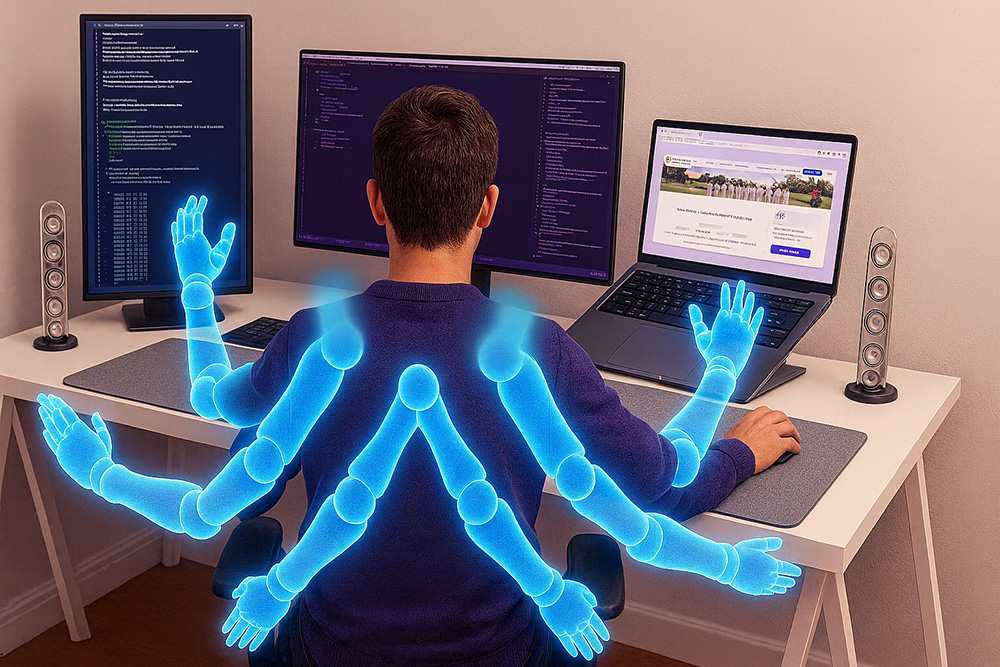The Product Team of One
I never planned to become a product team all by myself. Traditionally, building a product has always meant bringing together researchers, designers, developers, marketers, and product managers. Each role adds its own expertise, and the collective makes progress possible.
But something is shifting. With AI at our side, the lines between these roles are blurring. A motivated individual can now play all of them, not perfectly, but well enough to move an idea from concept to reality at surprising speed.
At Joinride, our side project for cyclists and runners, I live this reality almost every day together with my partner in crime, Lars. While we share the work, many of the tasks that once required a whole team of specialists I can now approach myself, supported by AI.
Wearing All the Hats
🕵️ The Researcher
When we introduced the new activities model in Joinride, we needed to understand how people would respond to the idea that the base is not only a ride, but an activity that can also be a run or an event. I gathered raw feedback from cyclists and runners. AI helped cluster their responses, highlight patterns, and surface where the concept clicked and where it created confusion. What would have taken a research team weeks came together in days.
🧑🎨 The Designer
The Quick Routes feature remembers the last routes you have used, so you can start again with just a tap. Normally, I would have explored endless variations in Figma to get the flow right. With AI, I generated different explorations, tested alternatives, and refined them quickly. Lars and I reviewed the outcomes and decided which approach felt most natural.
🧑💻 The Frontend Developer
I am not a career engineer, yet I built Joinride’s new activity detail pages in React and Tailwind. GitHub Copilot and Cursor became my pair programmers, scaffolding components, catching errors, and filling gaps in my knowledge. That freed up Lars to focus more on other parts of the system.
🧑🚀 The Backend Developer
Extending the data model for activities, so they can handle not only rides but also runs and events, felt complex at first. AI helped scaffold Prisma migrations, set up APIs, and debug schema changes. It was not flawless, but it lowered the barrier enough that I could handle backend work myself, which gave Lars and me more flexibility in dividing tasks.
👨🎤 The Marketer
When we launched the new activities model, we needed clear explanations for users. I drafted the texts, AI provided refinements, and I edited them for clarity and tone. Together, Lars and I could shift quickly from draft mode to community communication.
🧑💼 The Product Manager
When deciding whether to prioritize Quick Routes or extend the new activities model further, AI acted as a sounding board. It helped me map out user needs, risks, and technical trade-offs, which then gave Lars and me a clearer picture for making the call.
Opportunities
Being a “team of one,” or in our case, a “team of two multiplied by AI,” comes with clear advantages:
- Speed of iteration: We launched Quick Routes in days, something that once might have taken weeks.
- End-to-end ownership: From research to launch, one of us can now close the loop while the other moves the next piece forward.
- Empowerment of small teams: Joinride exists in a market with giants like Strava, but we can compete because AI multiplies what a small group can achieve.
Risks and Limits
Of course, the model is not without limits.
- Illusion of speed: A demo of Quick Routes can look polished, but refining the feature and integrating it properly still took time.
- Quality trade-offs: AI generated schema changes for the new activities model, but edge cases broke and required careful debugging.
- Expectation gaps: Early demos of Joinride looked finished, leading some to believe the product was ready, when in reality production delivery remained complex.
Culture Matters
This approach works well for Joinride because we are lean, motivated, and experimental. In a larger organization without a lean culture, AI can just as easily create noise: more slide decks, more half-baked prototypes, more confusion.
AI is not a magic fix. It is a multiplier. In the right cultural setting, it multiplies focus and outcomes. In the wrong one, it multiplies chaos.
The Future of Product Work
The “product team of one” does not mean teams are obsolete. It means one person can push an idea further before involving others, and small teams can punch far above their weight.
For Joinride, that has been the story from the start. A platform for cyclists and runners, built by a tiny crew of two, amplified by AI.
The future of product work is not about replacing people. It is about expanding what each of us can achieve when AI is at our side.


